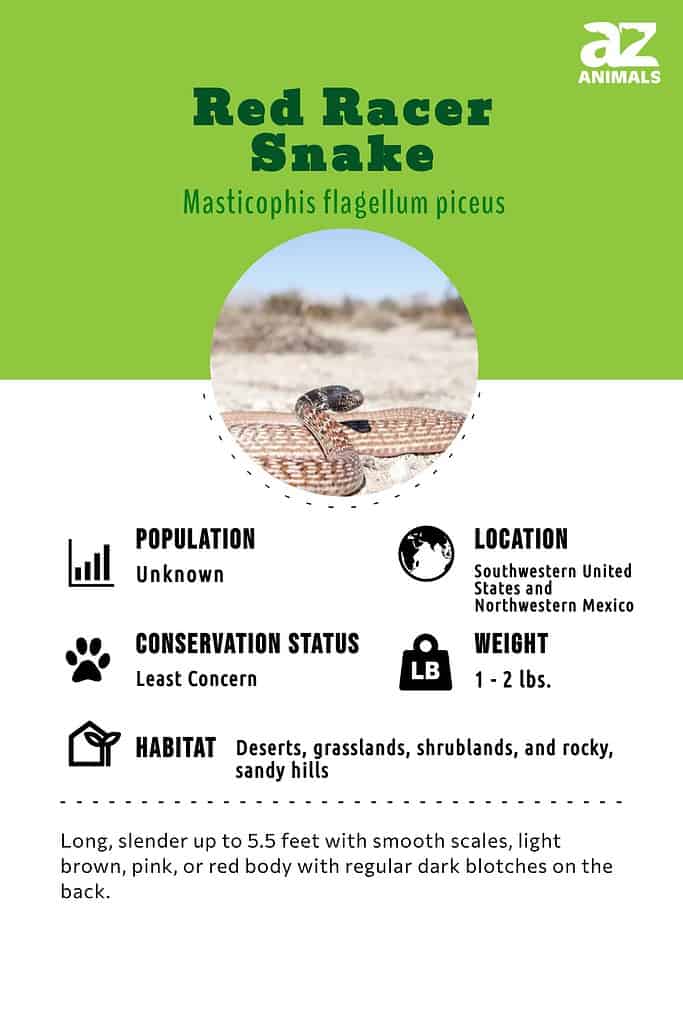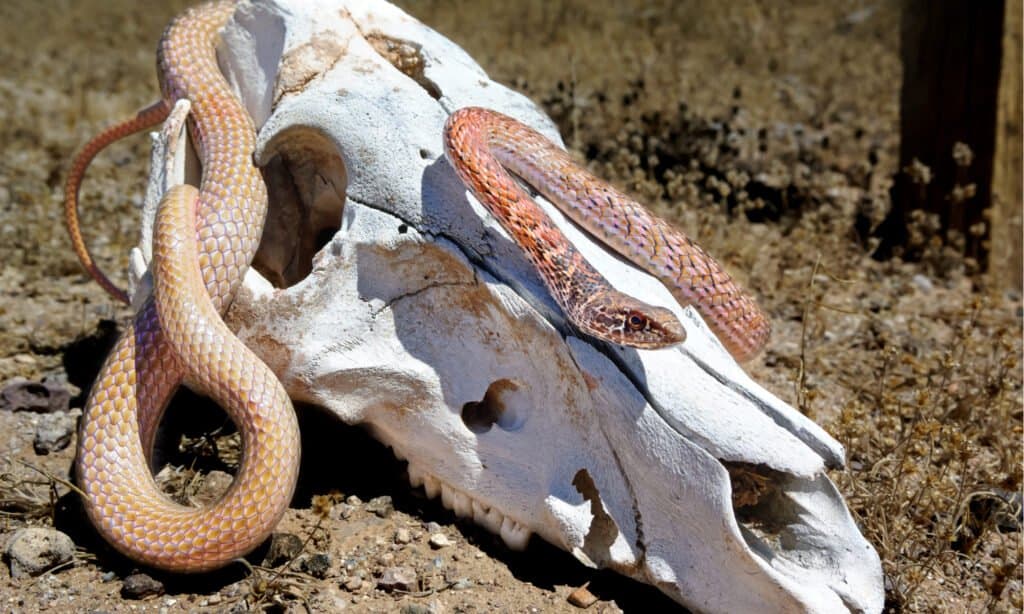Red Racer Snake
Masticophis flagellum piceus
Advertisement
Red Racer Snake Scientific Classification
- Kingdom
- Animalia
- Phylum
- Chordata
- Class
- Reptilia
- Order
- Squamata
- Family
- Colubridae
- Genus
- Masticophis
- Scientific Name
- Masticophis flagellum piceus
Read our Complete Guide to Classification of Animals.
Red Racer Snake Conservation Status
Red Racer Snake Facts
- Diet
- Carnivore
- Favorite Food
- Rodents, bats, frogs, lizards, snakes, birds, and eggs
- Common Name
- Red racer snake
Red Racer Snake Physical Characteristics
- Skin Type
- Scales
- Venomous
- No
- Aggression
- Medium
View all of the Red Racer Snake images!
The red racer is among the fastest snakes in North America.
The red racer, also known as the red coachwhip, is a subspecies of the coachwhip or whipsnake. The name should give you some idea of how fast they are. These snakes race along the ground with surprising speed when running away from threats or hunting for food. They are thought to be active during the day, basking near roads. They are not venomous and are generally considered to be harmless to humans.
4 Red Racer Snake Amazing Facts
- The red racer is thought to mate each year in May and lay a clutch of four to 20 eggs in the early summer. The eggs hatch after about 45 to 70 days. The small newborn whipsnakes have no other associations with their parents after hatching from the eggs.
- The red racer is thought to have a normal lifespan of 13 years in the wild and 20 years in captivity.
- The red racer is able to climb both trees and bushes with surprising skill.
- Like all other snakes, the red racer has an organ located on the roof of the mouth that senses odor from the air. When the snake flicks out its tongue, it draws the scent molecules into its mouth.

Where to Find Them
The red racer snake can be found in deserts, grasslands, shrublands, and rocky, sandy hills throughout the southwestern United States and northwestern Mexico. They prefer areas where the vegetation isn’t too dense and their speed provides a natural advantage. The Red racer snake take refuge in burrows, rocks, vegetation, trees, and other objects. Below is a list of the American and Mexican states where they can be found.

The red racer snake can be found in deserts, grasslands, shrublands, and rocky, sandy hills throughout the southwestern
United States
and northwestern
Mexico
.
©Jason Mintzer/Shutterstock.com
Scientific Name
The scientific name of the red racer snake is Masticophis flagellum piceus. Masticophis means tail whip in Greek. Flagellum also means whip or scourge in Latin. Piceus means pitch black in Latin as well. The red racer is one of six subspecies of the coachwhip snake along with the eastern coachwhip, western coachwhip, Sonoran coachwhip, and others.
Population & Conservation Status
The red racer snake whipsnake has not been evaluated by the IUCN Red List for its conservation status, but the coachwhip species, in general, is classified as least concern. Numbers appear to be very high and stable. These subspecies face no particular wild threats but sometimes fall victim to road accidents.
Appearance & Description
The red racer is a long, slender snake, generally measuring anywhere between 3 and 5.5 feet long. The body has a smooth braided appearance that resembles the whip of a coachman, giving the species its common name. It is often said to have a banded or saddled pattern with dark red or black blotches spaced regularly along the lighter red-colored body, although black and yellow morphs are also known to exist. The color scheme is thought to aid with camouflage in its natural habitat. Baby and juvenile red racers look similar to the adults, but the body may be more of a light brown or more tan than red. This species is sometimes confused with the San Joaquin coachwhip from central California and the western coachwhip from the other side of Colorado and New Mexico, but their range tends not to overlap very much.
Here is how to identify the red racer snake:
- Long, slender body measuring up to 5.5 feet.
- Smooth scales.
- Large scales above the eyes.
- Light brown, pink, or red body with regular dark blotches on the back.

History and Evolution
It might be surprising, but snakes at some point in history had legs, just like a lizard or some other reptile. It is interesting to think about how legs evolved for some species for millions of years only to become unnecessary for snakes. You can still see vestigial legs on some species of snakes. For multiple reasons such as avoiding predators and being closer to food sources, early snakes adapted to sleek on the ground, trees, and water and ultimately not use their legs as much.
All racer snakes have evolved to be notably fast. Being quick in the wild obviously gives many survival advantages to an animal species. Racers adapted to move faster than their prey and also faster than their predators.
How Dangerous Are They?
The red racer snake does not have the ability to produce any venom. They are generally considered to be harmless to humans. If bitten, however, you may experience some minor pain, swelling, and bleeding. You should wash out the wound with soap and water to prevent an infection. Medical attention is rarely required to deal with the bite unless the wound fails to heal properly.
There are definitely more dangerous species to worry about, but anyone who spends some time out in the wilderness of southern California, Nevada, Utah, or Arizona might want to be a little wary of this red-belly snake.

The red racer snake does not have the ability to produce any venom, and they are generally considered to be harmless to humans.
©Deep Desert Photography/Shutterstock.com
Behavior and Humans
The red racer snake is known to be quite skittish around people. If threatened, they may try to coil up and vibrate their bodies to scare away a potential predator by mimicking a rattlesnake. If that fails, they will also try to run away and hide under a nearby object or up a tree with surprising speed. Only when directly cornered or threatened will they attempt to lash out and bite at you.
Because they’re difficult to tame, red racers are generally not kept or sold as pets. They do not respond well to being handled and may bite out of self-defense. If you are interested in acquiring a pet snake, then you might want to find a tamer species.
View all 114 animals that start with RRed Racer Snake FAQs (Frequently Asked Questions)
Are red racer snakes venomous?
The red racer is a non-venomous snake.
How do red racer snakes hunt?
This red-belly snake will locate prey with its excellent sense of smell. When it has spotted a potential source of food, it will move its head back and forth to aid in depth perception. The snake is capable of very quick strikes. The prey is then crushed within the jaws or the coils of its body and swallowed whole.
Are red racer snakes aggressive?
This red-belly snake is only aggressive when directly threatened. They have very few predators in the wild except perhaps for coyotes and the great horned owl. Juveniles are the most likely to be killed by predators.
Where do red racer snakes live?
The red racer lives throughout the southwestern United States and northwestern Mexico, including around the Sierra Nevada Mountains, the Great Basin desert region, and the Sonora Desert. They are found most frequently in southern California and Arizona, but they are almost never found as far east as Colorado and New Mexico.
What do red racer snakes eat?
An adult red racer feeds on a large variety of different animals, including lizards, rodents, bats, frogs, small birds, eggs, and even other snakes. They also feed on dead carrion and roadkill. Baby and juveniles snakes may instead feeds on small invertebrates.
Do red racers whip you?
No, that is a myth. While their bodies do resemble long braided whips, it has nothing to do with their behavior. They don’t lash out with their tails or chase after people.
Will a red racer eat a rattlesnake?
Yes, they have been known to occasionally eat a small baby rattlesnake, but this is relatively rare.
Thank you for reading! Have some feedback for us? Contact the AZ Animals editorial team.
Sources
- California Herps / Accessed May 1, 2022
- Animal Diversity / Accessed May 1, 2022


















